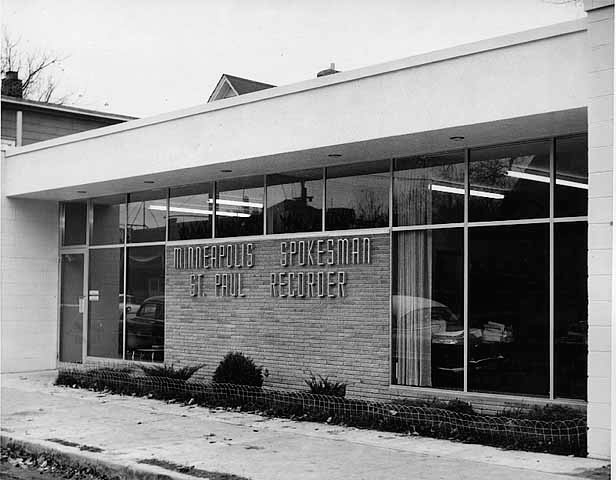About


1958 2015 |
Address: 3744 4th Avenue South
Neighborhood: Central
Construction Date: 1958
Contractor: Carlson-Lavine
Architect: Vernon K. Hosso
Architectural Style: Modern
Historic Use: Print Shop and Office
Current Use: Office
Date of Local Designation: 2015
Date of National Register Designation: N/A
Area(s) of Significance: Significant Events; Significant Persons; Neighborhood Identity
Period of Significance: 1958-1976
Historic Profile: The Minnesota Spokesman-Recorder building at 3744 Fourth Avenue South is historically significant for its association with the 20th-century African American civil rights movement; significant persons Cecil Newman and Gordon Parks; and its embodiment of neighborhood identity.
The Minnesota Spokesman-Recorder building is highly emblematic of the 20th-century African American civil rights movement in Minnesota. The building was built for, and continues to house, the longest running family owned African American newspaper in the state. Originally known as the Minneapolis Spokesman and Saint Paul Recorder before being combined, the two newspapers were a creation of publisher Cecil Newman in 1934. The first issues demonstrated Newman’s vision by collecting and publishing the stories of African Americans in the community while appealing to all races. The Spokesman-Recorder often blended the news from the community with what was going on around the U.S. in order to show the continuing challenge that African Americans faced and still struggle with today. During a time of legalized oppression, segregation, and widespread racism, the Minnesota Spokesman-Recorder became the only African American newspaper in Minnesota. Over its 80 plus years, the Spokesman-Recorder has used a solid journalism background to help mobilize Minnesota’s Africa-American communities in understanding the issues and events that are happening that either affect them or go unnoticed until it is too late.
This property is also historically significant for its association with the newspaper’s founder, editor, publisher, and civic leader, Cecil Newman, born in Kansas City, Missouri in July, 1903. Success did not come quickly or easily for Newman. Upon arriving in Minneapolis on May 22, 1922, he entered the newspaper business immediately, but had to take second jobs to support himself, first as a bellhop for the Elks Club and then as a Pullman porter. It was two years before Newman earned enough, even with his second job, to allow his wife and son to join him in Minneapolis. Newman tried his hand at publishing, first at a newspaper called the Twin City Herald, and then a monthly magazine called the Timely Digest. After these ventures ended in failure, he boldly quit his job at the Pullman Company and began not one but two newspapers in the middle of the Great Depression. After a decade the paper was reaching well over 7,000 people despite a population of only 15,000 African Americans in the Twin Cities.
Newman used his position to not only report news, but to improve conditions for African Americans. The first mail subscriber to the Spokesman-Recorder, national arms manufacturer Charles Horn, sought Newman’s help integrating African Americans into his defense plant. Other plants followed the procedures that Newman established, and they eventually became the standard in most war production plants. Newman established a longstanding relationship with late U.S. Vice President Hubert H. Humphrey, serving on his Council on Human Relations to improve the welfare of minorities in Minneapolis during Humphrey’s tenure as Mayor. Newman remained close to Humphrey when he won election to the U.S. Senate. Humphrey’s first bill in 1949 was civil rights legislation that served as a model for the U.S. Civil Rights Act of 1964. Newman also worked closely with Walter Mondale, Donald Fraser, Nellie Stone Johnson, Gordon Parks, and Carl Rowan to highlight and improve opportunities for African Americans.
The Minnesota Spokesman-Recorder building is also historically significant for its association with the late photographer, film maker, writer, and composer Gordon Parks. Gordon Parks was born in 1912, the youngest of 15 children in Fort Scott, Kansas, into poverty and segregation. When his mother passed away at the age of 14 he was sent to live in Minnesota with his sister until her husband kicked him out. This left Parks homeless in winter, living on the streets of St. Paul, and struggling to make ends meet. Among his ever-changing jobs, he worked as a piano player in a bordello, a hotel busboy, a civilian conservation corpsman, a porter, and later a waiter on the transcontinental North Coast Limited. After seeing the movie “Bombing of U.S.S. Panay” he was inspired by the photographer that stayed by his post to record all that happened. This inspired him to get a camera at 25 years old. Starting as a newspaper boy at the Spokesman-Recorder, he considered his camera, “his weapon against poverty and racism,” and over time started taking photographs, which were well represented in the column that Cecil Newman created for him called, “Beauty of the Week.” This provided Parks with the resources as a staff photographer to succeed and a career that led him to take memorable photos of Muhammad Ali, Malcom X, and Stokely Carmichael. Parks overcame severe discrimination to become the first black photographer at Life magazine and achieve pioneering accomplishments in publishing and film. Throughout his career, Parks used his power to bring the poverty and injustice experienced by African Americans into the national spotlight. His ability to capture what happened during the civil rights movement, as well as the segregation in Alabama in 1956, the movement of the Nation of Islam in the 1960s, and the assassination of Martin Luther King Jr., have made him arguably the most important black photographer in the history of photojournalism.
Finally, the Minnesota Spokesman-Recorder building is highly emblematic of embodiment of South Minneapolis' African American heritage and identity. The property is located along 4th Avenue South and 38th Street East: a central location for South Minneapolis' African American community. During and after World War II, the Central neighborhood and this intersection in particular attracted a large group of African American families. This immigration came with churches and other institutions that are still serving the community today. In the 1940s and 50s the neighborhood was home to grocery stores, banks, shoe stores, barbershops, Central High School, Sabathani Church, small community stores and the Spokesman-Recorder building. This area has a history of being a healthy, family-oriented area for middle to lower-middle class African Americans. The location of the Spokesman-Recorder building was ideal for its purpose of covering the local African American community, and from this strategic location it evolved into a prime resource utilized by African Americans in the neighborhood. Not only did the Spokesman-Recorder's reporting keep its audience abreast of local and national news that pertained to blacks, it was also a place where African Americans could identify local resources that served their needs during an era of legal and de facto segregation. This intrinsic neighborhood connection to the paper and to Cecil Newman helped connect African Americans to needed services while forging a path that called for social change.
Photo Credits:
1958 - Minnesota Historical Society
2015 - CPED Staff
Works Cited:
“Minnesota Spokesman-Recorder Designation Study,” 2015.
Updated: November 2015

